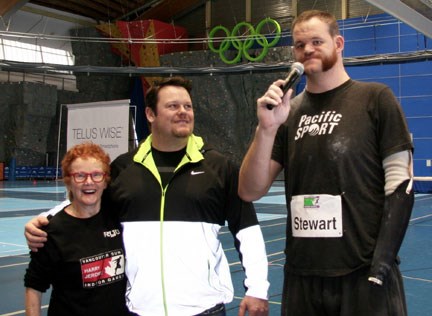Greg Stewart is excited about competing in his first Harry Jerome Track Classic on Tuesday where he will be looking forward to the opportunity to rub shoulders with the likes of Canadian Olympic sprint star Andre De Grasse.
“Of course, for me, it would be like rubbing hips to shoulders,” he says with a laugh over the phone from Kamloops.
No kidding. The Bunyanesque Stewart is a 7-foot-2, 320-pound behemoth who will tower over the 5-foot-9, 155-pound De Grasse, a triple medalist from the 2016 Rio de Janeiro Olympics.
Stewart, who turns 32 in July, won’t be found on the Swangard Stadium track. But in a field discipline filled with men of enormous girth, the shot putter will still be easily identifiable in the circle, not only for his massive size, but for the fact he was born without an arm below his left elbow.
That makes Stewart, the CIS defensive player of the year in 2011 when he played basketball for Thompson Rivers University with a prosthetic he likened to a “giant ping-pong paddle,” eligible to compete in the F46 class of para-athletics.
And given the way he was progressed in his year in the sport, and under the tutelage of Dylan Armstrong, the 2008 Olympic bronze medalist from Kamloops, Stewart looks like a sure bet to soon become a world record-holder and a 2020 Paralympic medalist.
His throw of 15.80 metres in Phoenix on Sunday was a personal best -- it marked a nearly two-metre increase in just one year -- and would have been good enough to win the F46 class gold medal at the 2017 Para-athletic world championships. It’s also just .18 off the world record held by American Josh Cinnamo.
“I was just hoping to go over 15 metres,” Stewart said, adding he was surprised when he launched a 15.27 on his first throw. “Then I went 15.67 and I was like ‘Whoa, what’s going on here?’ I was all jacked and amped.”
Armstrong says he and Stewart won’t be going to the Paralympic Games in Tokyo just to make the final. "We’re going to win.”
Stewart is less willing to publicly discuss that forecast, preferring to focus on technique and fundamentals, his maturing level of commitment as an athlete and the self-empowerment journey he’s been on the last four years.
“I really don’t know (what I’m capable of),” he says. “I just know I’m capable of being committed. I showed myself that over the last nine months. I know I can have fun, I know I can be a human being with work and competing and all that. I can make it work.”
After bouncing post-graduation between different jobs and cities, including Calgary and Prince George, while also playing for the national sitting and standing disabled volleyball teams, Stewart finally re-settled in Kamloops five years ago. With the help of a brother who works in the self-improvement field, Stewart says he’s found “a better life.”
“I’ve done a lot of mental work, spent a lot of time on graphic integration. I do a lot with feelings and love and self. It’s probably one of the biggest reasons I’m where I’m at. My connection to self, to love . . . it’s changed my whole perspective in life.”
A chance meeting at a 2016 Christmas party with a wheelchair sports coach led him to a development camp for para sports. Last October, he began training under the now-retired Armstrong and his legendary Ukrainian-born coach Dr. Anatoli Bodnarchuk.
“I’m extremely grateful,” says Stewart. “There’s no question (Armstrong) has got a wealth of knowledge and Dr. B is there too.”
Armstrong says he’s not surprised at Stewart’s quick progression.
“He’s got the body. Having those kind of levers, he’s co-ordinated, he’s athletic. It works for him. He’s got the tools to be able to throw far. Sometimes, I go ‘Oh, wow,’ but that being said, I know the system I’m using has a proven track record. Dr. B did the same with me. I’m very, very familiar with what has to happen.”
Armstrong says Stewart could hit the 16-metre mark this summer and “the sky’s the limit.”
Stewart says that after years of being involved in team sports, he’s enjoying the solitude of the shot-put circle, of focusing just on himself. “I’m definitely more committed than ever before.”
He never made a Paralympic Games with the volleyball teams, so to do so in 2020 would “mean almost everything . . . just to represent myself. And I’d be extremely grateful to represent the country. It’s a tough spot right now, with all the things going on in the world. But we as Canadians, we are good people. To represent a country that is loving, caring and connected, I’m very humbled by it.”
As for the Jerome, where he will compete alongside able-bodied throwers, Stewart says he goes in without any expectations.
“I want to take it all in. I’m not going to break any record. I just want to gain the experience. It’s all so fresh. I’m a rookie really. I just want an opportunity to build on this athletic resume.”



